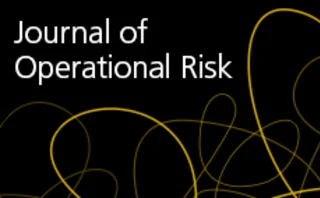Technical paper/Operational risk
An alternative approach for the operational risk assessment of a new product
The aim of this paper is to provide a new operational risk management framework to identify and mitigate the operational risk exposure arising from a new product.
Operational risk measurement: a loss distribution approach with segmented dependence
This paper proposes an approach, called the loss distribution approach with segmented dependence (LDA-SD), which can model the different dependencies of HFLI and LFHI losses in the framework of LDA.
A review of the state of the art in quantifying operational risk
In this paper, the authors provide a comprehensive review of the different approaches developed to model operational risk, specifically focusing on the actuarial approach.
Global perspectives on operational risk management and practice: a survey by the Institute of Operational Risk (IOR) and the Center for Financial Professionals (CeFPro)
This paper presents survey results which represent comprehensive perspectives on operational risk practice, obtained from practitioners in a wide range of countries and sectors.
Is operational risk regulation forward looking and sensitive to current risks?
This paper evaluates the operational risk capital requirements of large US banks to determine whether they are forward looking, sensitive to banks’ current exposures and designed to allow for risk mitigation.
Predictive fraud analytics: B-tests
In this paper, the authors look at B-tests: methods by which it is possible to identify internal fraud among employees and partners of the bank at an early stage.
A general framework for constructing bank risk data sets
This paper proposes a general framework for constructing bank risk data sets, which provides an integrated process from data sources to comprehensive risk data sets.
Forward-looking and incentive-compatible operational risk capital framework
This paper proposes an alternative framework for setting banks’ operational risk capital, which allows for forward-looking assessments and limits gaming opportunities by relying on an incentive-compatible mechanism.
Modeling operational risk depending on covariates: an empirical investigation
In this paper, the authors apply a dynamic extreme value theory (EVT) model based on a nonhomogeneous Poisson process incorporating covariates to estimate frequency, severity and risk measures for operational risk.
Risk monitoring through better knowledge-based risk processes
The aim of this paper is to propose a model that describes the integration of knowledge-based risks (via the processes of knowledge-based risk identification, analysis, evaluation and education) and knowledge-based risk repositories to support risk…
Operational risk: a forgotten case study
This paper is a historical case study of the GAS scandal and is the first to analyze it from the perspective of operational risk.
Operational risk measurement beyond the loss distribution approach: an exposure-based methodology
In this paper, the authors present an alternative quantification technique, so-called exposure-based operational risk (EBOR) models, which aim to replace historical severity curves by measures of current exposures and use event frequencies based on…
Distortion risk measures for nonnegative multivariate risks
In this paper, the authors present a way to address multivariate distortion risk measures and give some examples of distortion functions and distributions where the final expression has a closed form.
An operational risk capital model based on the loss distribution approach
In this paper, the author constructs a capital model for operational risk based on the observation that operational losses can, under a certain dimensional transformation, converge into a single, universal distribution.
Modeling very large losses
In this paper, the author presents a simple probabilistic model for aggregating very large losses into a loss collection.
Bridging networks, systems and controls frameworks for cybersecurity curriculums and standards development
This paper proposes a risk management framework designed to facilitate the alignment, integration and streamlining of professional practice standards and computer science/cybersecurity educational curriculums by bridging NPNATFs, SNIFs and RMCPFs.
Tail dependence in small samples: from theory to practice
In this paper, the authors study tail dependence by defining the conditions required for all the methods used to perform and to quantify their efficiency and accuracy.
Shapley allocation, diversification and services in operational risk
In this paper, the authors propose a method of allocating operational risk regulatory capital using a closed-form Shapley method, applicable to a large number of business units (BUs).
Modeling catastrophic operational risk using a compound Neyman–Scott clustering model
In this paper, the authors discuss the hazard generated by OpRisk driven by natural and human-made disasters, and argue the position of the LDA as the most-fitted statistical approach to deal with it.
The absence of evidence and the evidence of absence: an algorithmic approach for identifying operational outages in TARGET2
This paper implements an algorithmic approach to identify participants’operational outages based on transaction data.
The impact of de-tiering in the United Kingdom’s large-value payment system
The authors conduct a head-to-head comparison of central and bilateral clearing to evaluate the impact of market structure on market stability.
Standardized measurement approach extension to integrate insurance deduction into operational risk capital requirement
The SMA proposed in BCBS (2016) presents several issues: in particular, its two components are not sufficient to discriminate banking institutions by risk profile, thus penalizing the more virtuous ones. This paper describes a possible solution to extend…
The issues with the standardized measurement approach and a potential future direction for operational risk capital modeling
This paper discusses the criticism and praise the SMA and AMA have received, respectively, in many recent articles.
An operational risk-based regime-switching model for stock prices
This paper proposes a new risk-based regime-switching model for stock prices to examine the impact of operational risk events on stock prices.



